Climate Change and Anthropogenic Factors
VerifiedAdded on 2023/03/31
|14
|2893
|380
AI Summary
This article explores the relationship between climate change and anthropogenic factors. It discusses the impact of human activities on the environment and provides evidence of climate change. The article also examines how changes in land usage and greenhouse gas emissions contribute to climate change.
Contribute Materials
Your contribution can guide someone’s learning journey. Share your
documents today.
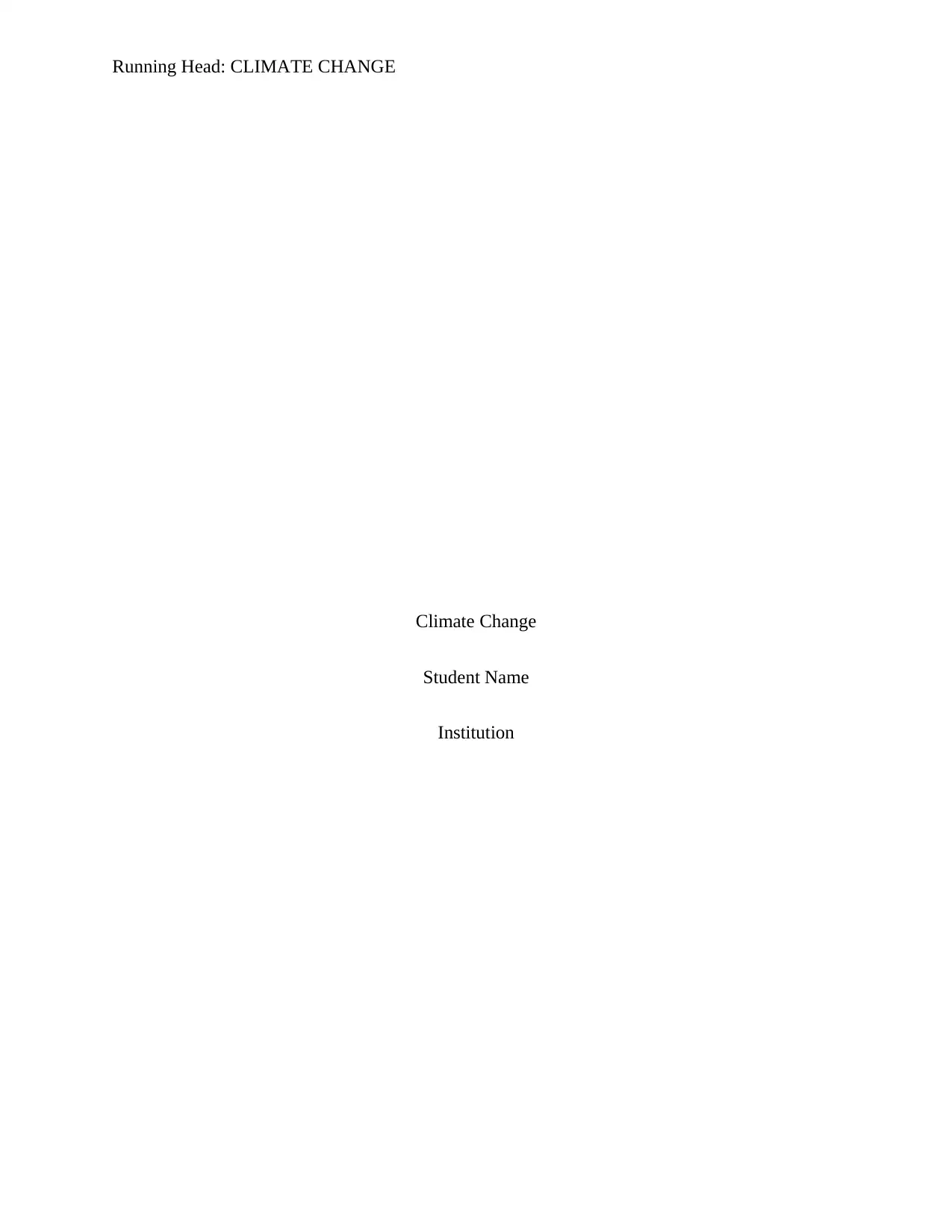
Running Head: CLIMATE CHANGE
Climate Change
Student Name
Institution
Climate Change
Student Name
Institution
Secure Best Marks with AI Grader
Need help grading? Try our AI Grader for instant feedback on your assignments.
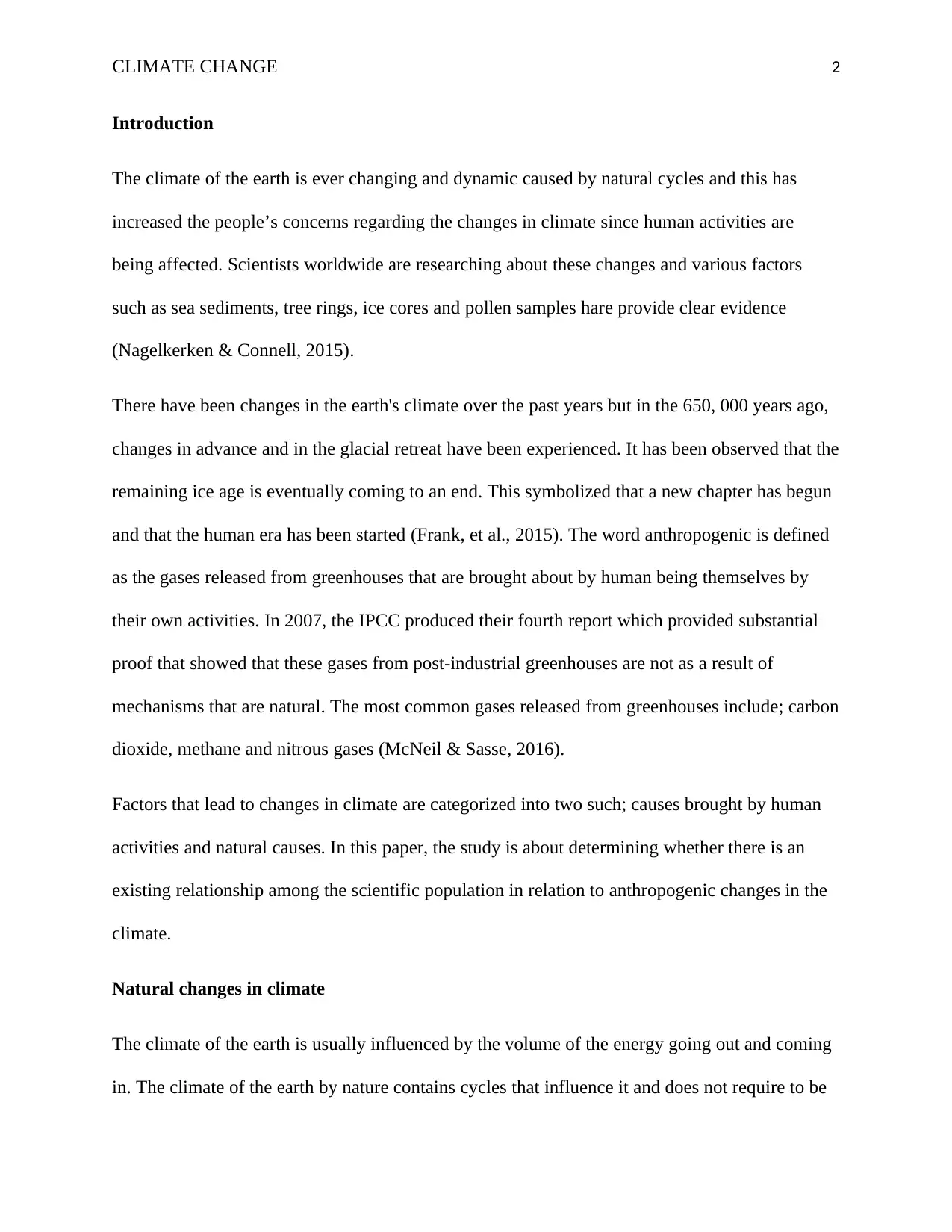
CLIMATE CHANGE 2
Introduction
The climate of the earth is ever changing and dynamic caused by natural cycles and this has
increased the people’s concerns regarding the changes in climate since human activities are
being affected. Scientists worldwide are researching about these changes and various factors
such as sea sediments, tree rings, ice cores and pollen samples hare provide clear evidence
(Nagelkerken & Connell, 2015).
There have been changes in the earth's climate over the past years but in the 650, 000 years ago,
changes in advance and in the glacial retreat have been experienced. It has been observed that the
remaining ice age is eventually coming to an end. This symbolized that a new chapter has begun
and that the human era has been started (Frank, et al., 2015). The word anthropogenic is defined
as the gases released from greenhouses that are brought about by human being themselves by
their own activities. In 2007, the IPCC produced their fourth report which provided substantial
proof that showed that these gases from post-industrial greenhouses are not as a result of
mechanisms that are natural. The most common gases released from greenhouses include; carbon
dioxide, methane and nitrous gases (McNeil & Sasse, 2016).
Factors that lead to changes in climate are categorized into two such; causes brought by human
activities and natural causes. In this paper, the study is about determining whether there is an
existing relationship among the scientific population in relation to anthropogenic changes in the
climate.
Natural changes in climate
The climate of the earth is usually influenced by the volume of the energy going out and coming
in. The climate of the earth by nature contains cycles that influence it and does not require to be
Introduction
The climate of the earth is ever changing and dynamic caused by natural cycles and this has
increased the people’s concerns regarding the changes in climate since human activities are
being affected. Scientists worldwide are researching about these changes and various factors
such as sea sediments, tree rings, ice cores and pollen samples hare provide clear evidence
(Nagelkerken & Connell, 2015).
There have been changes in the earth's climate over the past years but in the 650, 000 years ago,
changes in advance and in the glacial retreat have been experienced. It has been observed that the
remaining ice age is eventually coming to an end. This symbolized that a new chapter has begun
and that the human era has been started (Frank, et al., 2015). The word anthropogenic is defined
as the gases released from greenhouses that are brought about by human being themselves by
their own activities. In 2007, the IPCC produced their fourth report which provided substantial
proof that showed that these gases from post-industrial greenhouses are not as a result of
mechanisms that are natural. The most common gases released from greenhouses include; carbon
dioxide, methane and nitrous gases (McNeil & Sasse, 2016).
Factors that lead to changes in climate are categorized into two such; causes brought by human
activities and natural causes. In this paper, the study is about determining whether there is an
existing relationship among the scientific population in relation to anthropogenic changes in the
climate.
Natural changes in climate
The climate of the earth is usually influenced by the volume of the energy going out and coming
in. The climate of the earth by nature contains cycles that influence it and does not require to be
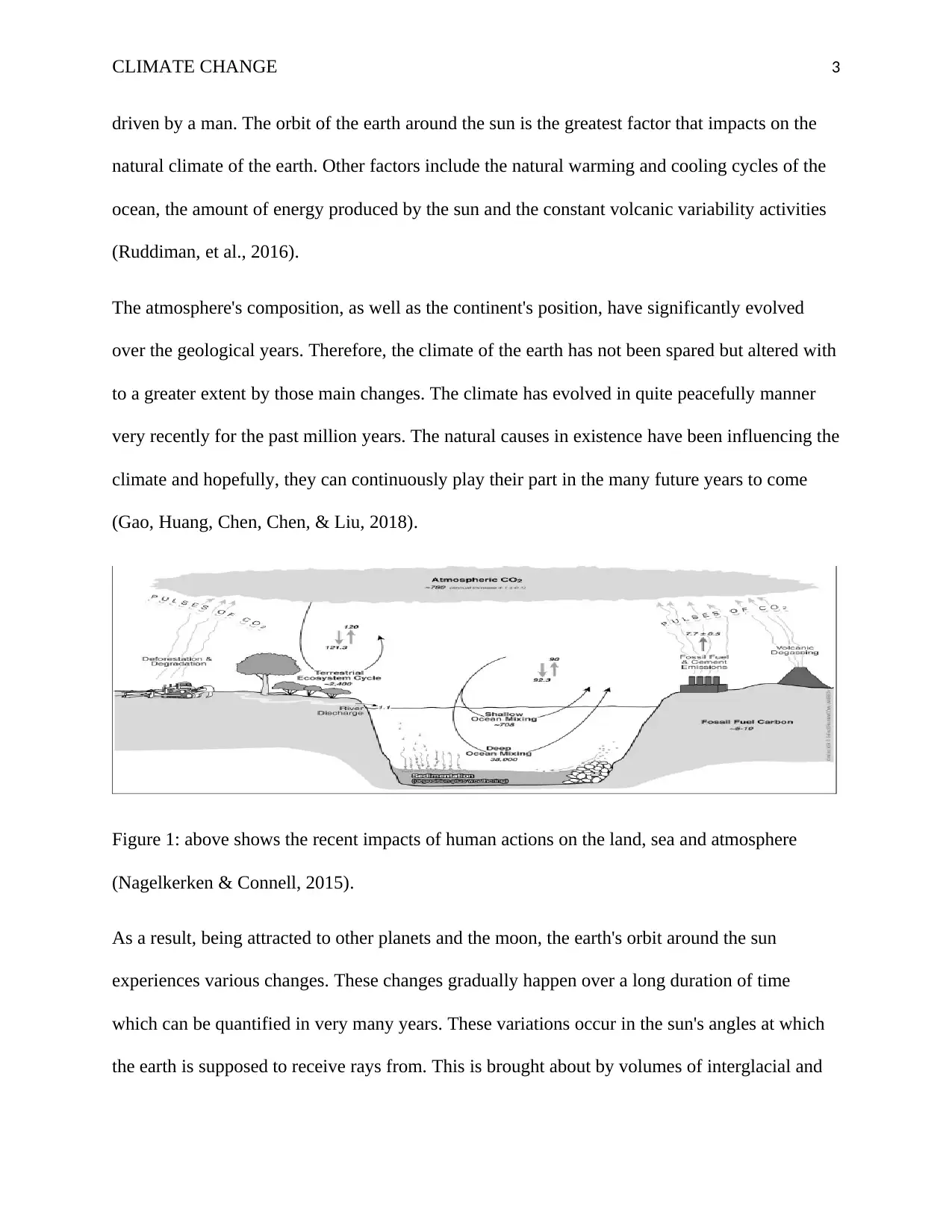
CLIMATE CHANGE 3
driven by a man. The orbit of the earth around the sun is the greatest factor that impacts on the
natural climate of the earth. Other factors include the natural warming and cooling cycles of the
ocean, the amount of energy produced by the sun and the constant volcanic variability activities
(Ruddiman, et al., 2016).
The atmosphere's composition, as well as the continent's position, have significantly evolved
over the geological years. Therefore, the climate of the earth has not been spared but altered with
to a greater extent by those main changes. The climate has evolved in quite peacefully manner
very recently for the past million years. The natural causes in existence have been influencing the
climate and hopefully, they can continuously play their part in the many future years to come
(Gao, Huang, Chen, Chen, & Liu, 2018).
Figure 1: above shows the recent impacts of human actions on the land, sea and atmosphere
(Nagelkerken & Connell, 2015).
As a result, being attracted to other planets and the moon, the earth's orbit around the sun
experiences various changes. These changes gradually happen over a long duration of time
which can be quantified in very many years. These variations occur in the sun's angles at which
the earth is supposed to receive rays from. This is brought about by volumes of interglacial and
driven by a man. The orbit of the earth around the sun is the greatest factor that impacts on the
natural climate of the earth. Other factors include the natural warming and cooling cycles of the
ocean, the amount of energy produced by the sun and the constant volcanic variability activities
(Ruddiman, et al., 2016).
The atmosphere's composition, as well as the continent's position, have significantly evolved
over the geological years. Therefore, the climate of the earth has not been spared but altered with
to a greater extent by those main changes. The climate has evolved in quite peacefully manner
very recently for the past million years. The natural causes in existence have been influencing the
climate and hopefully, they can continuously play their part in the many future years to come
(Gao, Huang, Chen, Chen, & Liu, 2018).
Figure 1: above shows the recent impacts of human actions on the land, sea and atmosphere
(Nagelkerken & Connell, 2015).
As a result, being attracted to other planets and the moon, the earth's orbit around the sun
experiences various changes. These changes gradually happen over a long duration of time
which can be quantified in very many years. These variations occur in the sun's angles at which
the earth is supposed to receive rays from. This is brought about by volumes of interglacial and
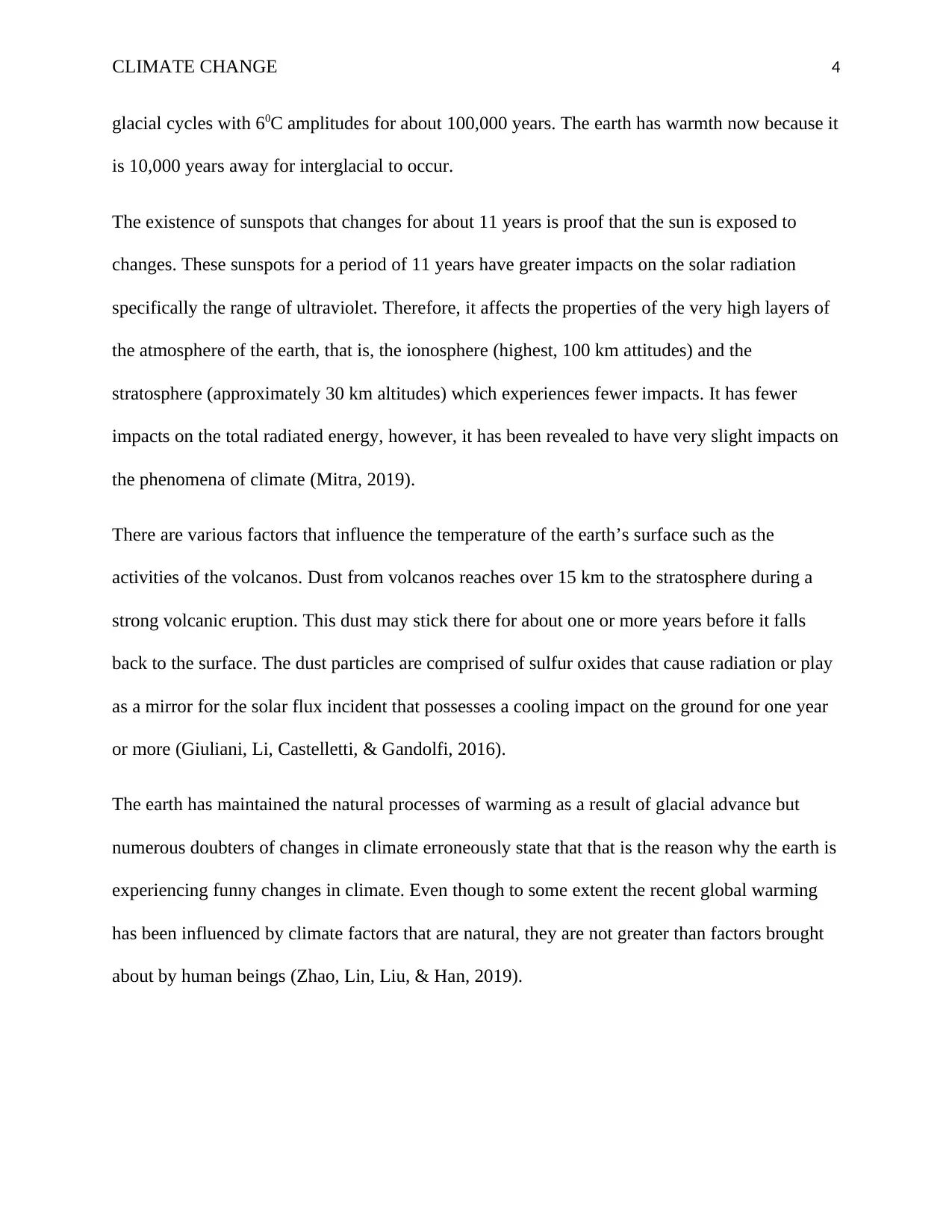
CLIMATE CHANGE 4
glacial cycles with 60C amplitudes for about 100,000 years. The earth has warmth now because it
is 10,000 years away for interglacial to occur.
The existence of sunspots that changes for about 11 years is proof that the sun is exposed to
changes. These sunspots for a period of 11 years have greater impacts on the solar radiation
specifically the range of ultraviolet. Therefore, it affects the properties of the very high layers of
the atmosphere of the earth, that is, the ionosphere (highest, 100 km attitudes) and the
stratosphere (approximately 30 km altitudes) which experiences fewer impacts. It has fewer
impacts on the total radiated energy, however, it has been revealed to have very slight impacts on
the phenomena of climate (Mitra, 2019).
There are various factors that influence the temperature of the earth’s surface such as the
activities of the volcanos. Dust from volcanos reaches over 15 km to the stratosphere during a
strong volcanic eruption. This dust may stick there for about one or more years before it falls
back to the surface. The dust particles are comprised of sulfur oxides that cause radiation or play
as a mirror for the solar flux incident that possesses a cooling impact on the ground for one year
or more (Giuliani, Li, Castelletti, & Gandolfi, 2016).
The earth has maintained the natural processes of warming as a result of glacial advance but
numerous doubters of changes in climate erroneously state that that is the reason why the earth is
experiencing funny changes in climate. Even though to some extent the recent global warming
has been influenced by climate factors that are natural, they are not greater than factors brought
about by human beings (Zhao, Lin, Liu, & Han, 2019).
glacial cycles with 60C amplitudes for about 100,000 years. The earth has warmth now because it
is 10,000 years away for interglacial to occur.
The existence of sunspots that changes for about 11 years is proof that the sun is exposed to
changes. These sunspots for a period of 11 years have greater impacts on the solar radiation
specifically the range of ultraviolet. Therefore, it affects the properties of the very high layers of
the atmosphere of the earth, that is, the ionosphere (highest, 100 km attitudes) and the
stratosphere (approximately 30 km altitudes) which experiences fewer impacts. It has fewer
impacts on the total radiated energy, however, it has been revealed to have very slight impacts on
the phenomena of climate (Mitra, 2019).
There are various factors that influence the temperature of the earth’s surface such as the
activities of the volcanos. Dust from volcanos reaches over 15 km to the stratosphere during a
strong volcanic eruption. This dust may stick there for about one or more years before it falls
back to the surface. The dust particles are comprised of sulfur oxides that cause radiation or play
as a mirror for the solar flux incident that possesses a cooling impact on the ground for one year
or more (Giuliani, Li, Castelletti, & Gandolfi, 2016).
The earth has maintained the natural processes of warming as a result of glacial advance but
numerous doubters of changes in climate erroneously state that that is the reason why the earth is
experiencing funny changes in climate. Even though to some extent the recent global warming
has been influenced by climate factors that are natural, they are not greater than factors brought
about by human beings (Zhao, Lin, Liu, & Han, 2019).
Secure Best Marks with AI Grader
Need help grading? Try our AI Grader for instant feedback on your assignments.
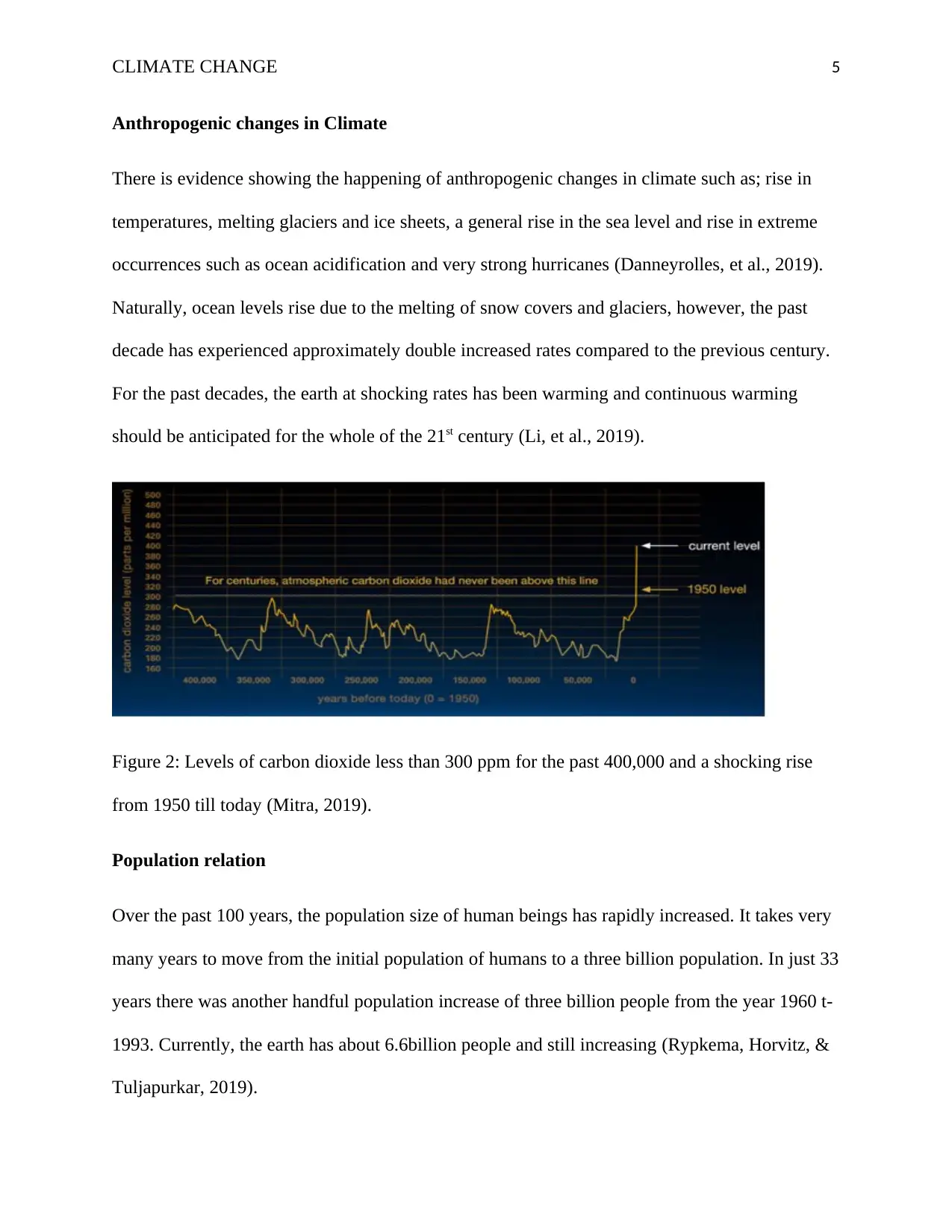
CLIMATE CHANGE 5
Anthropogenic changes in Climate
There is evidence showing the happening of anthropogenic changes in climate such as; rise in
temperatures, melting glaciers and ice sheets, a general rise in the sea level and rise in extreme
occurrences such as ocean acidification and very strong hurricanes (Danneyrolles, et al., 2019).
Naturally, ocean levels rise due to the melting of snow covers and glaciers, however, the past
decade has experienced approximately double increased rates compared to the previous century.
For the past decades, the earth at shocking rates has been warming and continuous warming
should be anticipated for the whole of the 21st century (Li, et al., 2019).
Figure 2: Levels of carbon dioxide less than 300 ppm for the past 400,000 and a shocking rise
from 1950 till today (Mitra, 2019).
Population relation
Over the past 100 years, the population size of human beings has rapidly increased. It takes very
many years to move from the initial population of humans to a three billion population. In just 33
years there was another handful population increase of three billion people from the year 1960 t-
1993. Currently, the earth has about 6.6billion people and still increasing (Rypkema, Horvitz, &
Tuljapurkar, 2019).
Anthropogenic changes in Climate
There is evidence showing the happening of anthropogenic changes in climate such as; rise in
temperatures, melting glaciers and ice sheets, a general rise in the sea level and rise in extreme
occurrences such as ocean acidification and very strong hurricanes (Danneyrolles, et al., 2019).
Naturally, ocean levels rise due to the melting of snow covers and glaciers, however, the past
decade has experienced approximately double increased rates compared to the previous century.
For the past decades, the earth at shocking rates has been warming and continuous warming
should be anticipated for the whole of the 21st century (Li, et al., 2019).
Figure 2: Levels of carbon dioxide less than 300 ppm for the past 400,000 and a shocking rise
from 1950 till today (Mitra, 2019).
Population relation
Over the past 100 years, the population size of human beings has rapidly increased. It takes very
many years to move from the initial population of humans to a three billion population. In just 33
years there was another handful population increase of three billion people from the year 1960 t-
1993. Currently, the earth has about 6.6billion people and still increasing (Rypkema, Horvitz, &
Tuljapurkar, 2019).

CLIMATE CHANGE 6
Figure 3: shows the population growth (Jorgenson et al., 2019).
The impact of growth in population in relation to changes in climate is very huge in nations with
greater emissions per-capita. For instance, there are very high rates of growth in population in a
number of African countries, however, there are very low emissions of greenhouse gases per
capita in the region (Barton, Terblanche, & Sinclair, 2019).
Increase in the projected consumption of energy in Africa is anticipated to cause lesser amounts
of emissions in the coming 25 years compared to other countries. The United States of America,
for example, is country with higher emissions per-capita as a result huge populations and of
higher rates of machines used in production.
Evidence of Eutrophication
The greatest risk to inland waters remains to be the anthropogenic eutrophication in many
regions of the world. However, re-oligotrophication is increasing fairly in various parts. The
major sources of pollution are the chemical fertilizers that highly contain phosphorous and
nitrogen. Domestic animals and treated soils may be the major sources of vaporous, nitrogen
Figure 3: shows the population growth (Jorgenson et al., 2019).
The impact of growth in population in relation to changes in climate is very huge in nations with
greater emissions per-capita. For instance, there are very high rates of growth in population in a
number of African countries, however, there are very low emissions of greenhouse gases per
capita in the region (Barton, Terblanche, & Sinclair, 2019).
Increase in the projected consumption of energy in Africa is anticipated to cause lesser amounts
of emissions in the coming 25 years compared to other countries. The United States of America,
for example, is country with higher emissions per-capita as a result huge populations and of
higher rates of machines used in production.
Evidence of Eutrophication
The greatest risk to inland waters remains to be the anthropogenic eutrophication in many
regions of the world. However, re-oligotrophication is increasing fairly in various parts. The
major sources of pollution are the chemical fertilizers that highly contain phosphorous and
nitrogen. Domestic animals and treated soils may be the major sources of vaporous, nitrogen
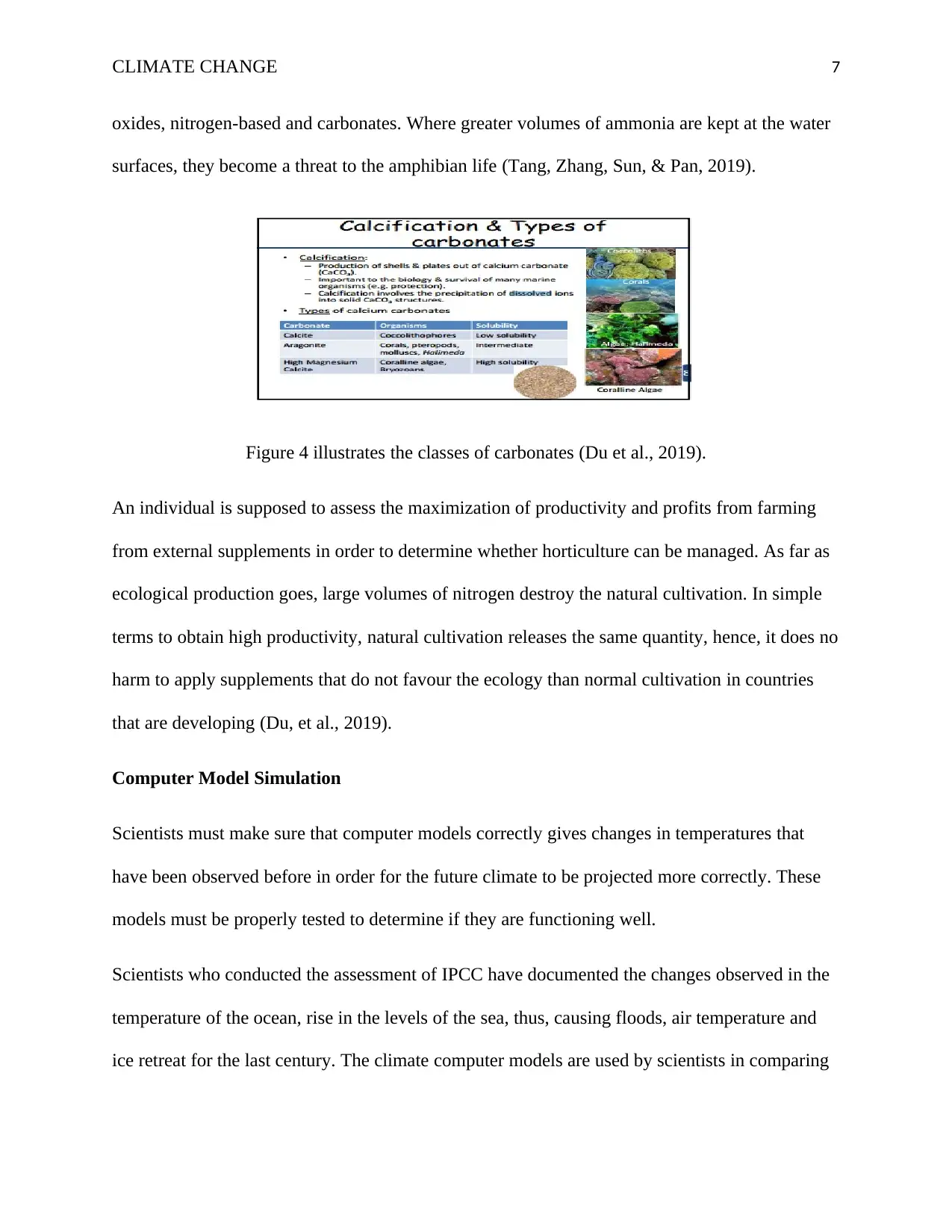
CLIMATE CHANGE 7
oxides, nitrogen-based and carbonates. Where greater volumes of ammonia are kept at the water
surfaces, they become a threat to the amphibian life (Tang, Zhang, Sun, & Pan, 2019).
Figure 4 illustrates the classes of carbonates (Du et al., 2019).
An individual is supposed to assess the maximization of productivity and profits from farming
from external supplements in order to determine whether horticulture can be managed. As far as
ecological production goes, large volumes of nitrogen destroy the natural cultivation. In simple
terms to obtain high productivity, natural cultivation releases the same quantity, hence, it does no
harm to apply supplements that do not favour the ecology than normal cultivation in countries
that are developing (Du, et al., 2019).
Computer Model Simulation
Scientists must make sure that computer models correctly gives changes in temperatures that
have been observed before in order for the future climate to be projected more correctly. These
models must be properly tested to determine if they are functioning well.
Scientists who conducted the assessment of IPCC have documented the changes observed in the
temperature of the ocean, rise in the levels of the sea, thus, causing floods, air temperature and
ice retreat for the last century. The climate computer models are used by scientists in comparing
oxides, nitrogen-based and carbonates. Where greater volumes of ammonia are kept at the water
surfaces, they become a threat to the amphibian life (Tang, Zhang, Sun, & Pan, 2019).
Figure 4 illustrates the classes of carbonates (Du et al., 2019).
An individual is supposed to assess the maximization of productivity and profits from farming
from external supplements in order to determine whether horticulture can be managed. As far as
ecological production goes, large volumes of nitrogen destroy the natural cultivation. In simple
terms to obtain high productivity, natural cultivation releases the same quantity, hence, it does no
harm to apply supplements that do not favour the ecology than normal cultivation in countries
that are developing (Du, et al., 2019).
Computer Model Simulation
Scientists must make sure that computer models correctly gives changes in temperatures that
have been observed before in order for the future climate to be projected more correctly. These
models must be properly tested to determine if they are functioning well.
Scientists who conducted the assessment of IPCC have documented the changes observed in the
temperature of the ocean, rise in the levels of the sea, thus, causing floods, air temperature and
ice retreat for the last century. The climate computer models are used by scientists in comparing
Paraphrase This Document
Need a fresh take? Get an instant paraphrase of this document with our AI Paraphraser
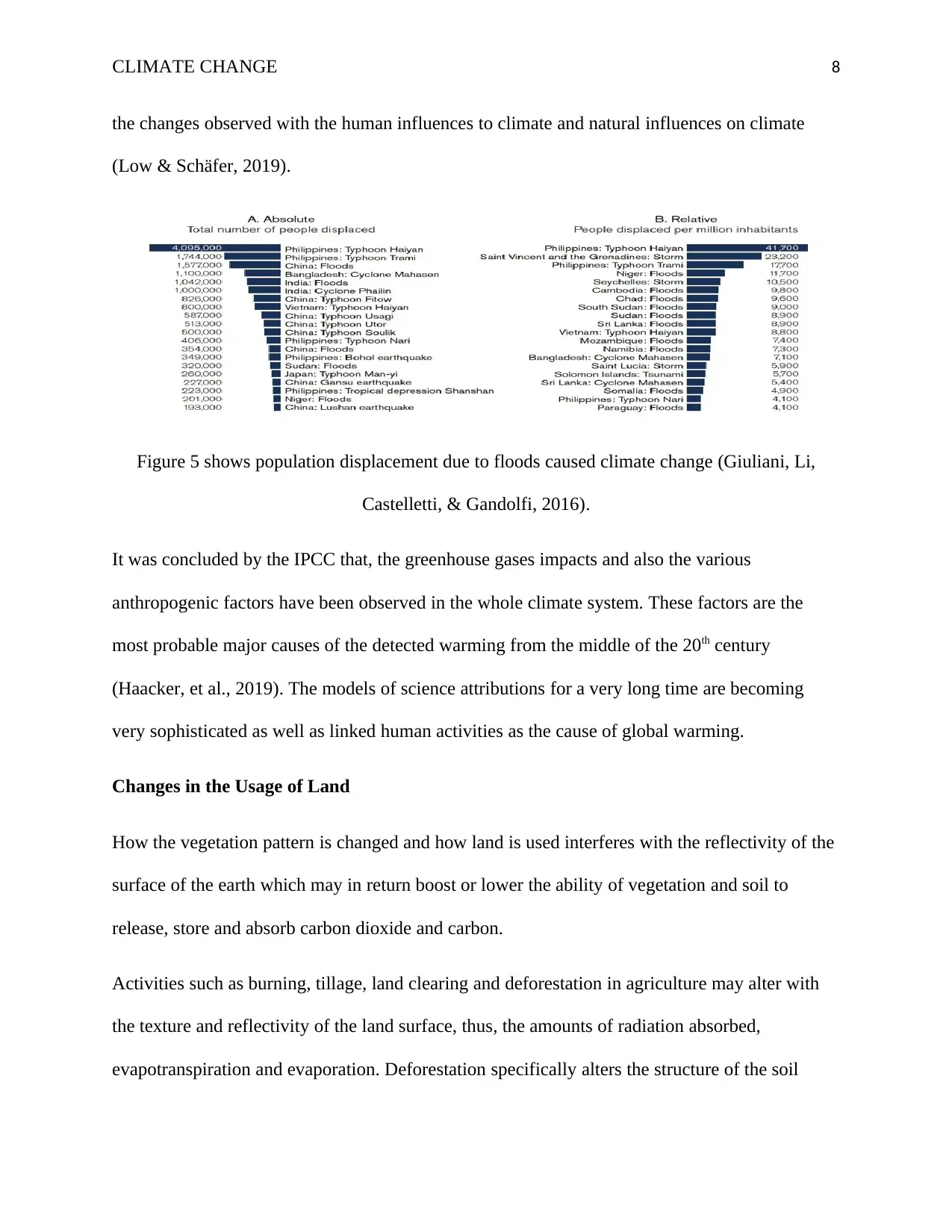
CLIMATE CHANGE 8
the changes observed with the human influences to climate and natural influences on climate
(Low & Schäfer, 2019).
Figure 5 shows population displacement due to floods caused climate change (Giuliani, Li,
Castelletti, & Gandolfi, 2016).
It was concluded by the IPCC that, the greenhouse gases impacts and also the various
anthropogenic factors have been observed in the whole climate system. These factors are the
most probable major causes of the detected warming from the middle of the 20th century
(Haacker, et al., 2019). The models of science attributions for a very long time are becoming
very sophisticated as well as linked human activities as the cause of global warming.
Changes in the Usage of Land
How the vegetation pattern is changed and how land is used interferes with the reflectivity of the
surface of the earth which may in return boost or lower the ability of vegetation and soil to
release, store and absorb carbon dioxide and carbon.
Activities such as burning, tillage, land clearing and deforestation in agriculture may alter with
the texture and reflectivity of the land surface, thus, the amounts of radiation absorbed,
evapotranspiration and evaporation. Deforestation specifically alters the structure of the soil
the changes observed with the human influences to climate and natural influences on climate
(Low & Schäfer, 2019).
Figure 5 shows population displacement due to floods caused climate change (Giuliani, Li,
Castelletti, & Gandolfi, 2016).
It was concluded by the IPCC that, the greenhouse gases impacts and also the various
anthropogenic factors have been observed in the whole climate system. These factors are the
most probable major causes of the detected warming from the middle of the 20th century
(Haacker, et al., 2019). The models of science attributions for a very long time are becoming
very sophisticated as well as linked human activities as the cause of global warming.
Changes in the Usage of Land
How the vegetation pattern is changed and how land is used interferes with the reflectivity of the
surface of the earth which may in return boost or lower the ability of vegetation and soil to
release, store and absorb carbon dioxide and carbon.
Activities such as burning, tillage, land clearing and deforestation in agriculture may alter with
the texture and reflectivity of the land surface, thus, the amounts of radiation absorbed,
evapotranspiration and evaporation. Deforestation specifically alters the structure of the soil
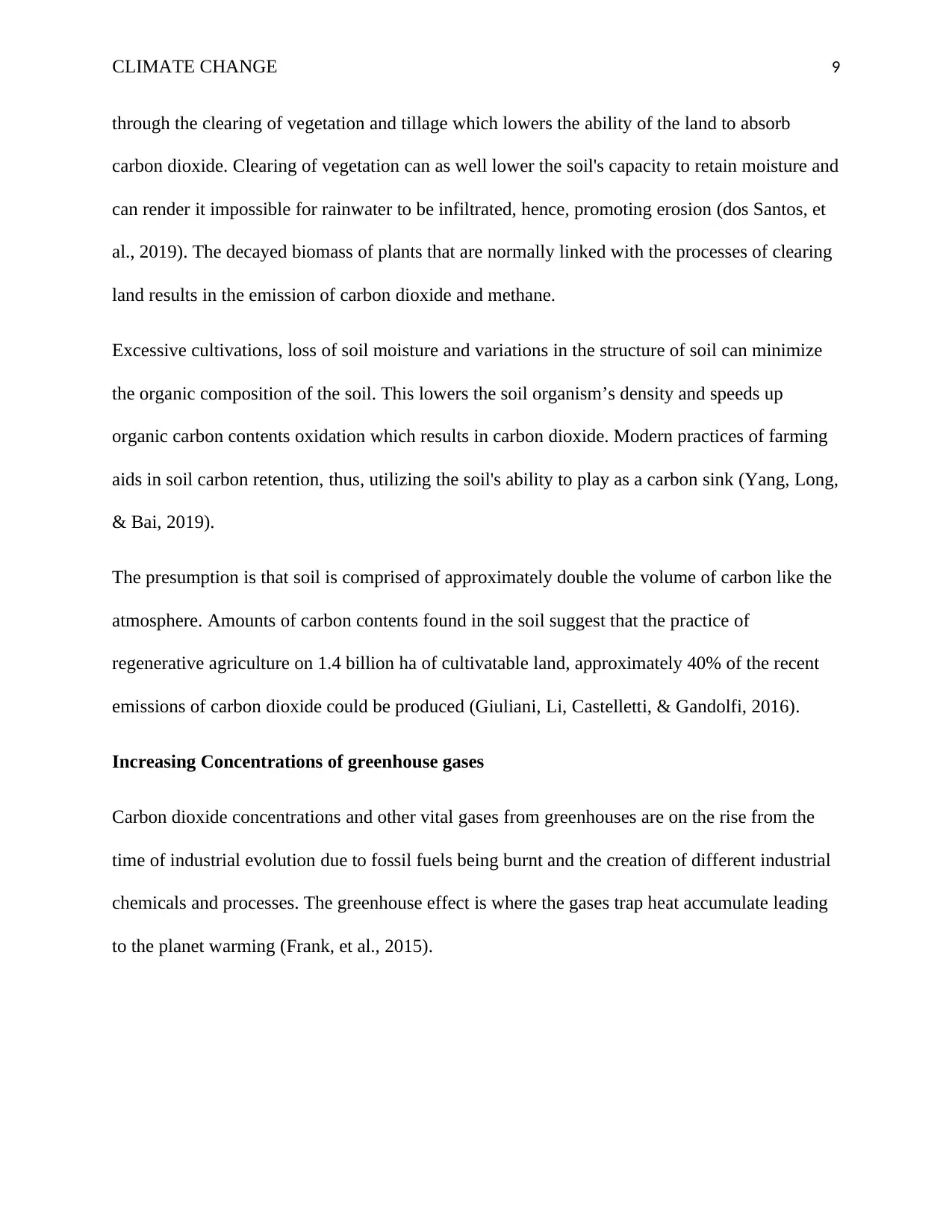
CLIMATE CHANGE 9
through the clearing of vegetation and tillage which lowers the ability of the land to absorb
carbon dioxide. Clearing of vegetation can as well lower the soil's capacity to retain moisture and
can render it impossible for rainwater to be infiltrated, hence, promoting erosion (dos Santos, et
al., 2019). The decayed biomass of plants that are normally linked with the processes of clearing
land results in the emission of carbon dioxide and methane.
Excessive cultivations, loss of soil moisture and variations in the structure of soil can minimize
the organic composition of the soil. This lowers the soil organism’s density and speeds up
organic carbon contents oxidation which results in carbon dioxide. Modern practices of farming
aids in soil carbon retention, thus, utilizing the soil's ability to play as a carbon sink (Yang, Long,
& Bai, 2019).
The presumption is that soil is comprised of approximately double the volume of carbon like the
atmosphere. Amounts of carbon contents found in the soil suggest that the practice of
regenerative agriculture on 1.4 billion ha of cultivatable land, approximately 40% of the recent
emissions of carbon dioxide could be produced (Giuliani, Li, Castelletti, & Gandolfi, 2016).
Increasing Concentrations of greenhouse gases
Carbon dioxide concentrations and other vital gases from greenhouses are on the rise from the
time of industrial evolution due to fossil fuels being burnt and the creation of different industrial
chemicals and processes. The greenhouse effect is where the gases trap heat accumulate leading
to the planet warming (Frank, et al., 2015).
through the clearing of vegetation and tillage which lowers the ability of the land to absorb
carbon dioxide. Clearing of vegetation can as well lower the soil's capacity to retain moisture and
can render it impossible for rainwater to be infiltrated, hence, promoting erosion (dos Santos, et
al., 2019). The decayed biomass of plants that are normally linked with the processes of clearing
land results in the emission of carbon dioxide and methane.
Excessive cultivations, loss of soil moisture and variations in the structure of soil can minimize
the organic composition of the soil. This lowers the soil organism’s density and speeds up
organic carbon contents oxidation which results in carbon dioxide. Modern practices of farming
aids in soil carbon retention, thus, utilizing the soil's ability to play as a carbon sink (Yang, Long,
& Bai, 2019).
The presumption is that soil is comprised of approximately double the volume of carbon like the
atmosphere. Amounts of carbon contents found in the soil suggest that the practice of
regenerative agriculture on 1.4 billion ha of cultivatable land, approximately 40% of the recent
emissions of carbon dioxide could be produced (Giuliani, Li, Castelletti, & Gandolfi, 2016).
Increasing Concentrations of greenhouse gases
Carbon dioxide concentrations and other vital gases from greenhouses are on the rise from the
time of industrial evolution due to fossil fuels being burnt and the creation of different industrial
chemicals and processes. The greenhouse effect is where the gases trap heat accumulate leading
to the planet warming (Frank, et al., 2015).
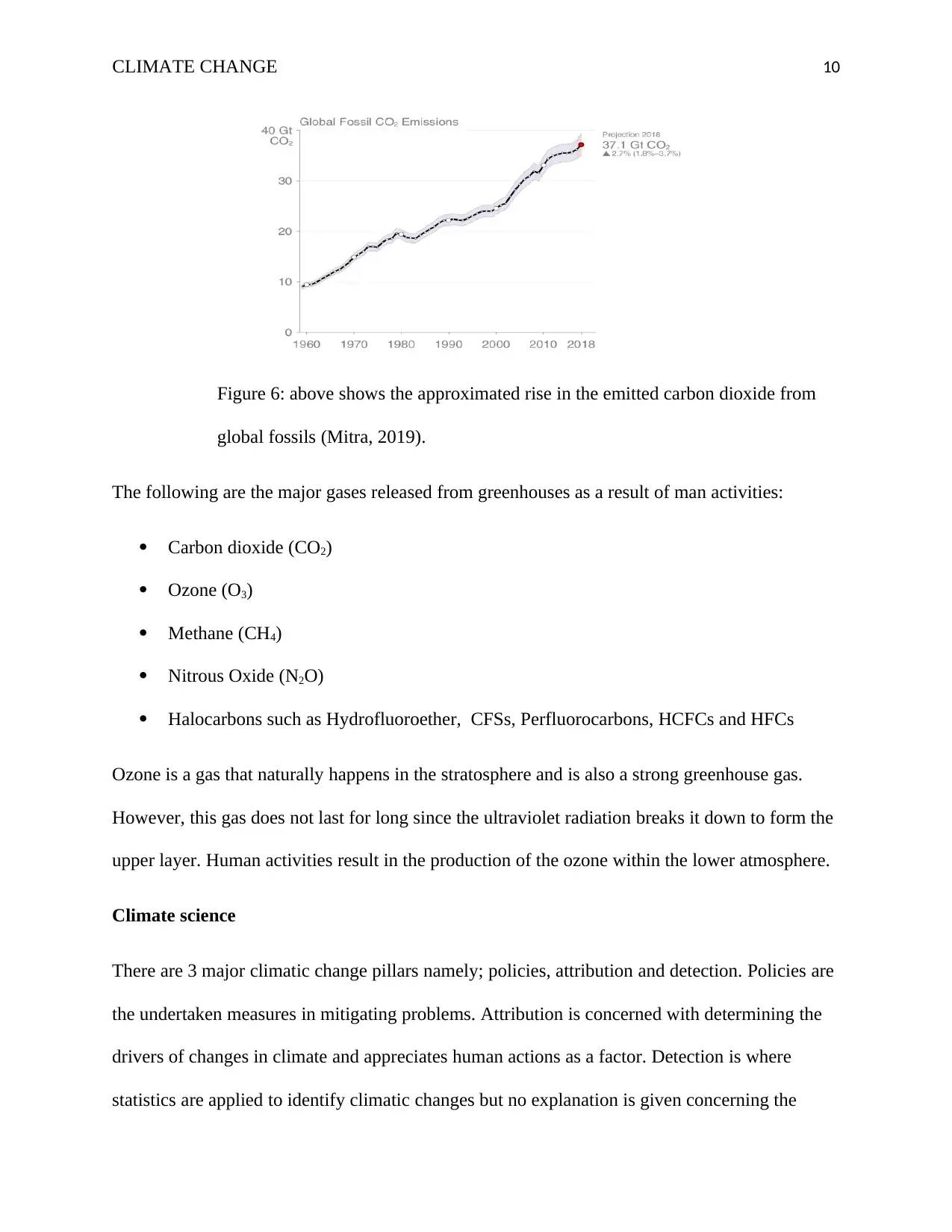
CLIMATE CHANGE 10
Figure 6: above shows the approximated rise in the emitted carbon dioxide from
global fossils (Mitra, 2019).
The following are the major gases released from greenhouses as a result of man activities:
Carbon dioxide (CO2)
Ozone (O3)
Methane (CH4)
Nitrous Oxide (N2O)
Halocarbons such as Hydrofluoroether, CFSs, Perfluorocarbons, HCFCs and HFCs
Ozone is a gas that naturally happens in the stratosphere and is also a strong greenhouse gas.
However, this gas does not last for long since the ultraviolet radiation breaks it down to form the
upper layer. Human activities result in the production of the ozone within the lower atmosphere.
Climate science
There are 3 major climatic change pillars namely; policies, attribution and detection. Policies are
the undertaken measures in mitigating problems. Attribution is concerned with determining the
drivers of changes in climate and appreciates human actions as a factor. Detection is where
statistics are applied to identify climatic changes but no explanation is given concerning the
Figure 6: above shows the approximated rise in the emitted carbon dioxide from
global fossils (Mitra, 2019).
The following are the major gases released from greenhouses as a result of man activities:
Carbon dioxide (CO2)
Ozone (O3)
Methane (CH4)
Nitrous Oxide (N2O)
Halocarbons such as Hydrofluoroether, CFSs, Perfluorocarbons, HCFCs and HFCs
Ozone is a gas that naturally happens in the stratosphere and is also a strong greenhouse gas.
However, this gas does not last for long since the ultraviolet radiation breaks it down to form the
upper layer. Human activities result in the production of the ozone within the lower atmosphere.
Climate science
There are 3 major climatic change pillars namely; policies, attribution and detection. Policies are
the undertaken measures in mitigating problems. Attribution is concerned with determining the
drivers of changes in climate and appreciates human actions as a factor. Detection is where
statistics are applied to identify climatic changes but no explanation is given concerning the
Secure Best Marks with AI Grader
Need help grading? Try our AI Grader for instant feedback on your assignments.

CLIMATE CHANGE 11
variations. Science is very unpredictable since it only addresses possibilities but not certainties
(Tàbara, Jäger, Mangalagiu, & Grasso, 2019). In cases when possibilities are proven beyond
doubts then it is reasonable to term an issue as resolved. The scientific class was worried about
the issue that human actions resulted in climate changes, but, disagreements arose as to whether
the warming and cooling impacts were as a result of global warming. The IPCC presented
reports that were very accurate and attributed the increase in global warming to the greenhouse
anthropogenic gases (Beebe, Baghramian, Drury, & Dellsén, 2019).
Conclusion
Human actions are the major drivers of climate changes. However, there are other minor natural
factors that contribute to change in the climate. Changes in climate caused by man have a direct
connection with the volumes of burned fossil fuels, deforestation, agricultural activities and
aerosols. With the evolution of industries, there has been a high rise in climatic changes and
temperatures (Jorgenson, et al., 2019). The planet got into the Anthropocene era where
substantial growth in human population resulted in huge human impacts on the earth. The most
endangering climate change effects are the ice mass melting then leading to a rise in the levels of
the sea causing floods and danger to the coastal surroundings (Giuliani, Li, Castelletti, &
Gandolfi, 2016).
variations. Science is very unpredictable since it only addresses possibilities but not certainties
(Tàbara, Jäger, Mangalagiu, & Grasso, 2019). In cases when possibilities are proven beyond
doubts then it is reasonable to term an issue as resolved. The scientific class was worried about
the issue that human actions resulted in climate changes, but, disagreements arose as to whether
the warming and cooling impacts were as a result of global warming. The IPCC presented
reports that were very accurate and attributed the increase in global warming to the greenhouse
anthropogenic gases (Beebe, Baghramian, Drury, & Dellsén, 2019).
Conclusion
Human actions are the major drivers of climate changes. However, there are other minor natural
factors that contribute to change in the climate. Changes in climate caused by man have a direct
connection with the volumes of burned fossil fuels, deforestation, agricultural activities and
aerosols. With the evolution of industries, there has been a high rise in climatic changes and
temperatures (Jorgenson, et al., 2019). The planet got into the Anthropocene era where
substantial growth in human population resulted in huge human impacts on the earth. The most
endangering climate change effects are the ice mass melting then leading to a rise in the levels of
the sea causing floods and danger to the coastal surroundings (Giuliani, Li, Castelletti, &
Gandolfi, 2016).
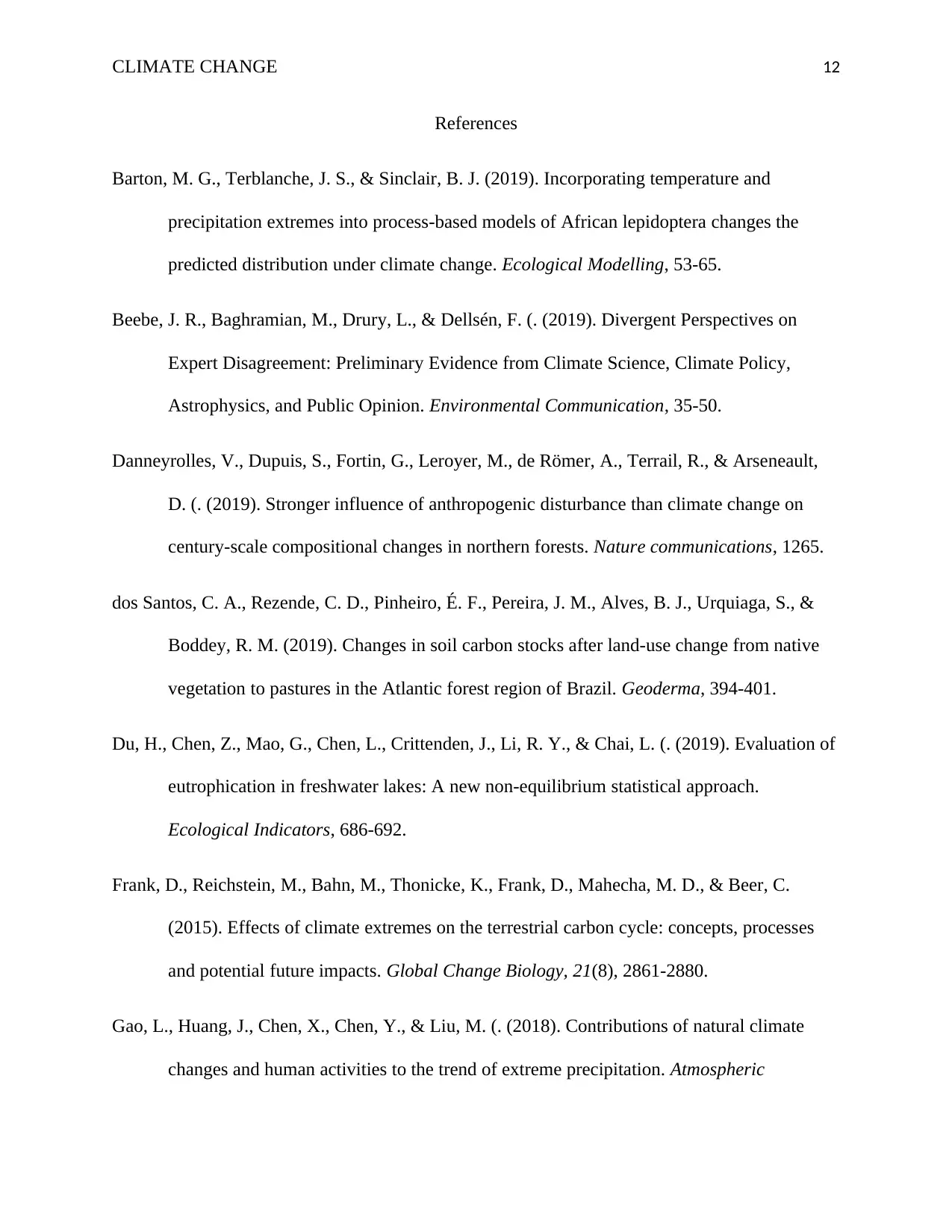
CLIMATE CHANGE 12
References
Barton, M. G., Terblanche, J. S., & Sinclair, B. J. (2019). Incorporating temperature and
precipitation extremes into process-based models of African lepidoptera changes the
predicted distribution under climate change. Ecological Modelling, 53-65.
Beebe, J. R., Baghramian, M., Drury, L., & Dellsén, F. (. (2019). Divergent Perspectives on
Expert Disagreement: Preliminary Evidence from Climate Science, Climate Policy,
Astrophysics, and Public Opinion. Environmental Communication, 35-50.
Danneyrolles, V., Dupuis, S., Fortin, G., Leroyer, M., de Römer, A., Terrail, R., & Arseneault,
D. (. (2019). Stronger influence of anthropogenic disturbance than climate change on
century-scale compositional changes in northern forests. Nature communications, 1265.
dos Santos, C. A., Rezende, C. D., Pinheiro, É. F., Pereira, J. M., Alves, B. J., Urquiaga, S., &
Boddey, R. M. (2019). Changes in soil carbon stocks after land-use change from native
vegetation to pastures in the Atlantic forest region of Brazil. Geoderma, 394-401.
Du, H., Chen, Z., Mao, G., Chen, L., Crittenden, J., Li, R. Y., & Chai, L. (. (2019). Evaluation of
eutrophication in freshwater lakes: A new non-equilibrium statistical approach.
Ecological Indicators, 686-692.
Frank, D., Reichstein, M., Bahn, M., Thonicke, K., Frank, D., Mahecha, M. D., & Beer, C.
(2015). Effects of climate extremes on the terrestrial carbon cycle: concepts, processes
and potential future impacts. Global Change Biology, 21(8), 2861-2880.
Gao, L., Huang, J., Chen, X., Chen, Y., & Liu, M. (. (2018). Contributions of natural climate
changes and human activities to the trend of extreme precipitation. Atmospheric
References
Barton, M. G., Terblanche, J. S., & Sinclair, B. J. (2019). Incorporating temperature and
precipitation extremes into process-based models of African lepidoptera changes the
predicted distribution under climate change. Ecological Modelling, 53-65.
Beebe, J. R., Baghramian, M., Drury, L., & Dellsén, F. (. (2019). Divergent Perspectives on
Expert Disagreement: Preliminary Evidence from Climate Science, Climate Policy,
Astrophysics, and Public Opinion. Environmental Communication, 35-50.
Danneyrolles, V., Dupuis, S., Fortin, G., Leroyer, M., de Römer, A., Terrail, R., & Arseneault,
D. (. (2019). Stronger influence of anthropogenic disturbance than climate change on
century-scale compositional changes in northern forests. Nature communications, 1265.
dos Santos, C. A., Rezende, C. D., Pinheiro, É. F., Pereira, J. M., Alves, B. J., Urquiaga, S., &
Boddey, R. M. (2019). Changes in soil carbon stocks after land-use change from native
vegetation to pastures in the Atlantic forest region of Brazil. Geoderma, 394-401.
Du, H., Chen, Z., Mao, G., Chen, L., Crittenden, J., Li, R. Y., & Chai, L. (. (2019). Evaluation of
eutrophication in freshwater lakes: A new non-equilibrium statistical approach.
Ecological Indicators, 686-692.
Frank, D., Reichstein, M., Bahn, M., Thonicke, K., Frank, D., Mahecha, M. D., & Beer, C.
(2015). Effects of climate extremes on the terrestrial carbon cycle: concepts, processes
and potential future impacts. Global Change Biology, 21(8), 2861-2880.
Gao, L., Huang, J., Chen, X., Chen, Y., & Liu, M. (. (2018). Contributions of natural climate
changes and human activities to the trend of extreme precipitation. Atmospheric
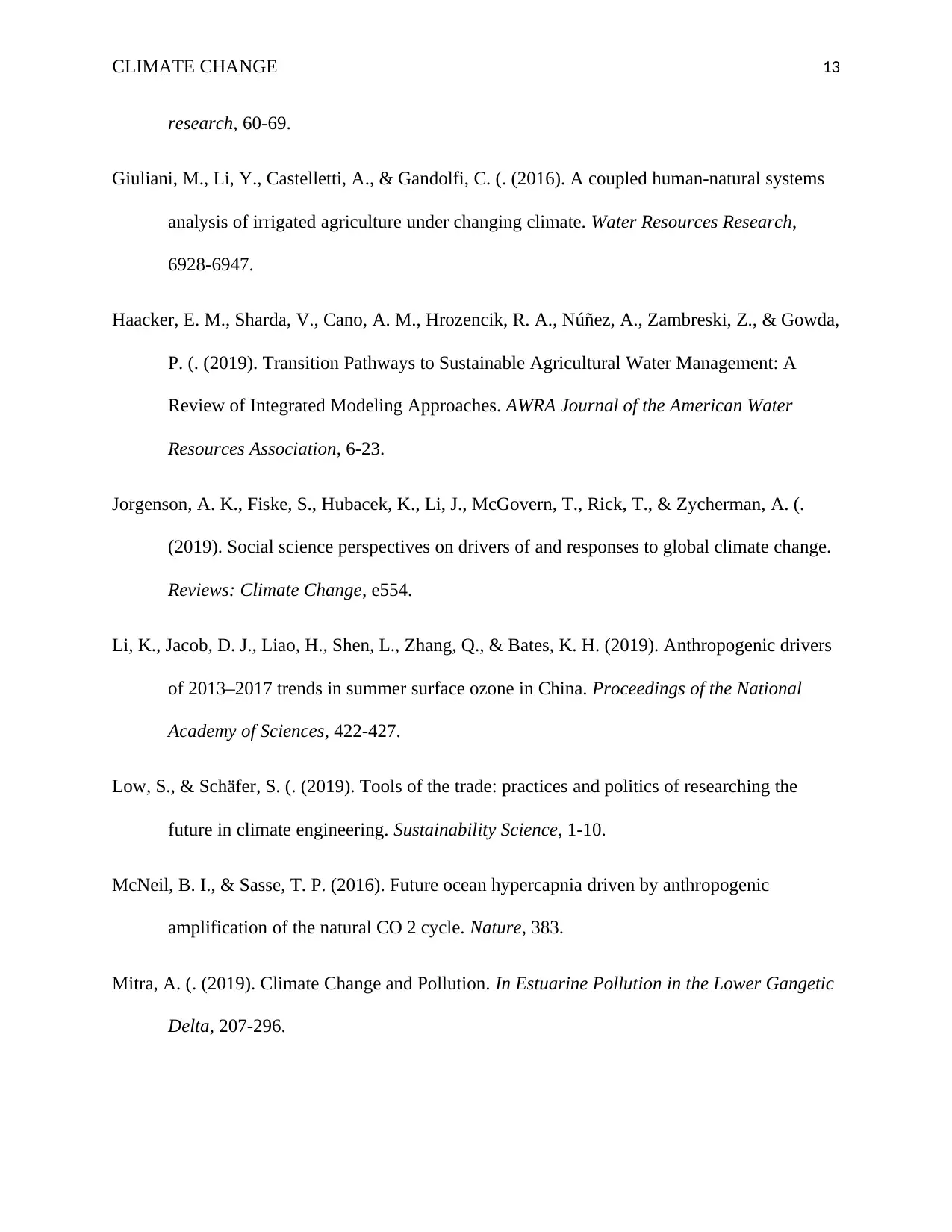
CLIMATE CHANGE 13
research, 60-69.
Giuliani, M., Li, Y., Castelletti, A., & Gandolfi, C. (. (2016). A coupled human‐natural systems
analysis of irrigated agriculture under changing climate. Water Resources Research,
6928-6947.
Haacker, E. M., Sharda, V., Cano, A. M., Hrozencik, R. A., Núñez, A., Zambreski, Z., & Gowda,
P. (. (2019). Transition Pathways to Sustainable Agricultural Water Management: A
Review of Integrated Modeling Approaches. AWRA Journal of the American Water
Resources Association, 6-23.
Jorgenson, A. K., Fiske, S., Hubacek, K., Li, J., McGovern, T., Rick, T., & Zycherman, A. (.
(2019). Social science perspectives on drivers of and responses to global climate change.
Reviews: Climate Change, e554.
Li, K., Jacob, D. J., Liao, H., Shen, L., Zhang, Q., & Bates, K. H. (2019). Anthropogenic drivers
of 2013–2017 trends in summer surface ozone in China. Proceedings of the National
Academy of Sciences, 422-427.
Low, S., & Schäfer, S. (. (2019). Tools of the trade: practices and politics of researching the
future in climate engineering. Sustainability Science, 1-10.
McNeil, B. I., & Sasse, T. P. (2016). Future ocean hypercapnia driven by anthropogenic
amplification of the natural CO 2 cycle. Nature, 383.
Mitra, A. (. (2019). Climate Change and Pollution. In Estuarine Pollution in the Lower Gangetic
Delta, 207-296.
research, 60-69.
Giuliani, M., Li, Y., Castelletti, A., & Gandolfi, C. (. (2016). A coupled human‐natural systems
analysis of irrigated agriculture under changing climate. Water Resources Research,
6928-6947.
Haacker, E. M., Sharda, V., Cano, A. M., Hrozencik, R. A., Núñez, A., Zambreski, Z., & Gowda,
P. (. (2019). Transition Pathways to Sustainable Agricultural Water Management: A
Review of Integrated Modeling Approaches. AWRA Journal of the American Water
Resources Association, 6-23.
Jorgenson, A. K., Fiske, S., Hubacek, K., Li, J., McGovern, T., Rick, T., & Zycherman, A. (.
(2019). Social science perspectives on drivers of and responses to global climate change.
Reviews: Climate Change, e554.
Li, K., Jacob, D. J., Liao, H., Shen, L., Zhang, Q., & Bates, K. H. (2019). Anthropogenic drivers
of 2013–2017 trends in summer surface ozone in China. Proceedings of the National
Academy of Sciences, 422-427.
Low, S., & Schäfer, S. (. (2019). Tools of the trade: practices and politics of researching the
future in climate engineering. Sustainability Science, 1-10.
McNeil, B. I., & Sasse, T. P. (2016). Future ocean hypercapnia driven by anthropogenic
amplification of the natural CO 2 cycle. Nature, 383.
Mitra, A. (. (2019). Climate Change and Pollution. In Estuarine Pollution in the Lower Gangetic
Delta, 207-296.
Paraphrase This Document
Need a fresh take? Get an instant paraphrase of this document with our AI Paraphraser
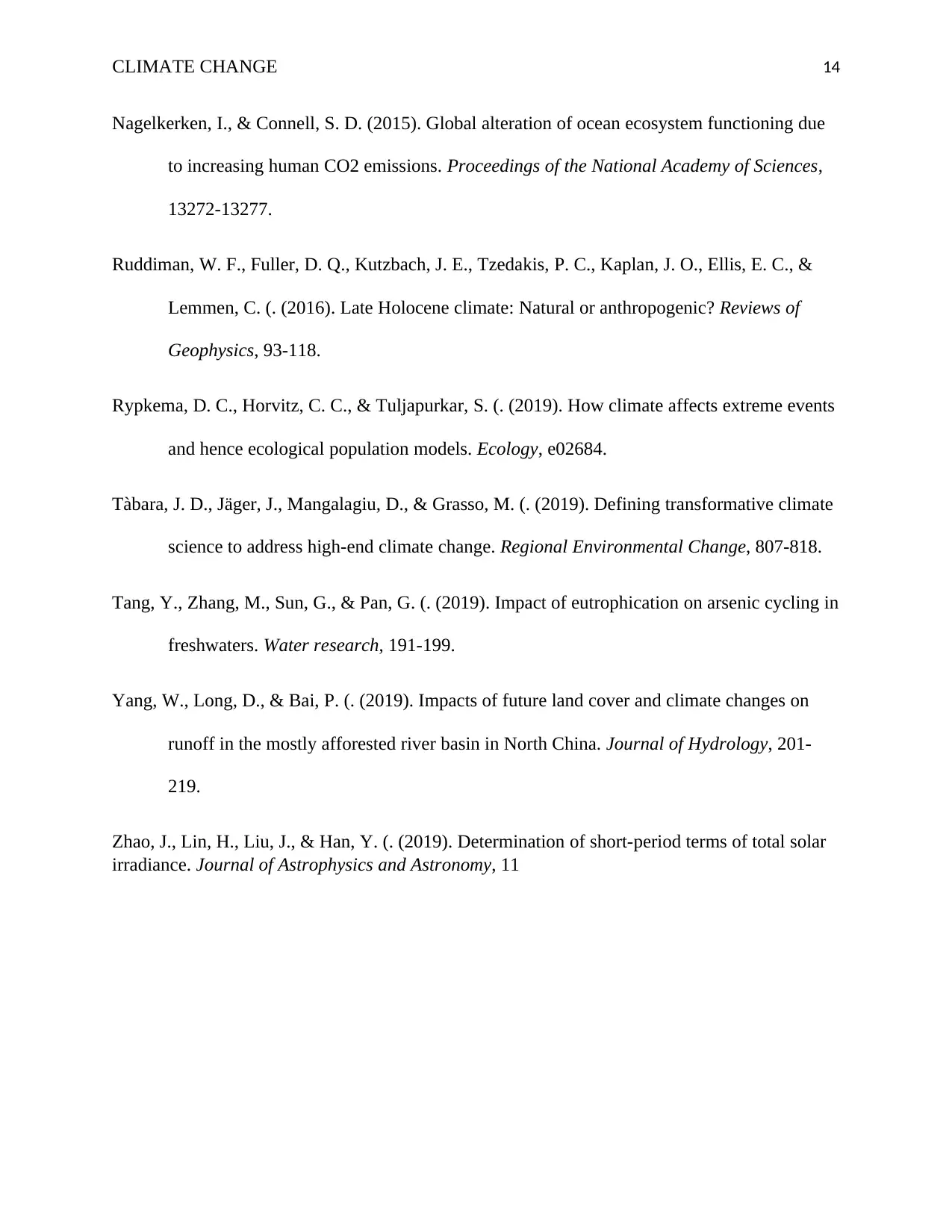
CLIMATE CHANGE 14
Nagelkerken, I., & Connell, S. D. (2015). Global alteration of ocean ecosystem functioning due
to increasing human CO2 emissions. Proceedings of the National Academy of Sciences,
13272-13277.
Ruddiman, W. F., Fuller, D. Q., Kutzbach, J. E., Tzedakis, P. C., Kaplan, J. O., Ellis, E. C., &
Lemmen, C. (. (2016). Late Holocene climate: Natural or anthropogenic? Reviews of
Geophysics, 93-118.
Rypkema, D. C., Horvitz, C. C., & Tuljapurkar, S. (. (2019). How climate affects extreme events
and hence ecological population models. Ecology, e02684.
Tàbara, J. D., Jäger, J., Mangalagiu, D., & Grasso, M. (. (2019). Defining transformative climate
science to address high-end climate change. Regional Environmental Change, 807-818.
Tang, Y., Zhang, M., Sun, G., & Pan, G. (. (2019). Impact of eutrophication on arsenic cycling in
freshwaters. Water research, 191-199.
Yang, W., Long, D., & Bai, P. (. (2019). Impacts of future land cover and climate changes on
runoff in the mostly afforested river basin in North China. Journal of Hydrology, 201-
219.
Zhao, J., Lin, H., Liu, J., & Han, Y. (. (2019). Determination of short-period terms of total solar
irradiance. Journal of Astrophysics and Astronomy, 11
Nagelkerken, I., & Connell, S. D. (2015). Global alteration of ocean ecosystem functioning due
to increasing human CO2 emissions. Proceedings of the National Academy of Sciences,
13272-13277.
Ruddiman, W. F., Fuller, D. Q., Kutzbach, J. E., Tzedakis, P. C., Kaplan, J. O., Ellis, E. C., &
Lemmen, C. (. (2016). Late Holocene climate: Natural or anthropogenic? Reviews of
Geophysics, 93-118.
Rypkema, D. C., Horvitz, C. C., & Tuljapurkar, S. (. (2019). How climate affects extreme events
and hence ecological population models. Ecology, e02684.
Tàbara, J. D., Jäger, J., Mangalagiu, D., & Grasso, M. (. (2019). Defining transformative climate
science to address high-end climate change. Regional Environmental Change, 807-818.
Tang, Y., Zhang, M., Sun, G., & Pan, G. (. (2019). Impact of eutrophication on arsenic cycling in
freshwaters. Water research, 191-199.
Yang, W., Long, D., & Bai, P. (. (2019). Impacts of future land cover and climate changes on
runoff in the mostly afforested river basin in North China. Journal of Hydrology, 201-
219.
Zhao, J., Lin, H., Liu, J., & Han, Y. (. (2019). Determination of short-period terms of total solar
irradiance. Journal of Astrophysics and Astronomy, 11
1 out of 14
Related Documents
Your All-in-One AI-Powered Toolkit for Academic Success.
+13062052269
info@desklib.com
Available 24*7 on WhatsApp / Email
![[object Object]](/_next/static/media/star-bottom.7253800d.svg)
Unlock your academic potential
© 2024 | Zucol Services PVT LTD | All rights reserved.



